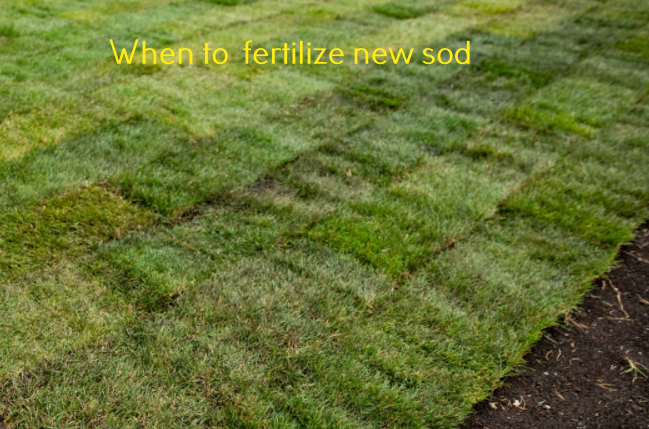Fertilizing new sod helps the grass establish quickly, and you can have a thick green lawn within a short period of time. To get the best results, you must know when to fertilize new sod and what fertilizer to use.
For best results, fertilize a new sod 4 to 6 weeks after the installation, with a well-balanced slow-release granular fertilizer formulated for new lawns. Starter fertilizer may also be used before laying the sod for quick results.

When to Fertilize New Sod
Fertilizing a new sod gives your turf a boost for vigorous growth. However, this has to be done using the right starter fertilizer for lawn grass. Starter lawn fertilizers come in different N-P-K compositions of (nitrogen (N), phosphorous (P), and potassium (K).
- Nitrogen: Needed for growth and green coloration of plants.
- Phosphorous: Promotes various growth processes in the plant, including good root development.
- Potassium: Promotes good resistance to diseases and enhances the tolerance of plants to drought and winter conditions.
Even though sod is mostly composed of mature turf, most of the roots get severed during harvesting. Fertilizing the soil before sod is laid will greatly help hasten the development of new roots.
Starter fertilizer should not be applied directly to the newly installed sod as it can cause the burning of the grass. Additionally, fertilizer applied only to the surface of the sod will take longer for nutrients to move down, which will delay its usefulness to the grass.
Starter fertilizer should be applied 4 to 6 weeks after laying the sod. This is probably a few days after mowing new sod for the first time. A well-rooted sod enables the grass to absorb and use nutrients from the fertilizer.
If you fertilize your new sod too early, the nutrients won’t be quickly absorbed as roots are still developing. This results in a lot of the fertilizer will be washed into nearby water bodies, which is harmful to aquatic life.
The nutrients could also leach from the soil leading to a deficiency when the grass needs it.
How to Fertilize New Sod
Starter fertilizer will definitely promote healthy growth and the establishment of your lawn. However, applying too much can be harmful to your turf. Although every fertilizer has clear application instructions, here is how to apply your starter fertilizer properly.
- Measure the square footage of your lawn area to determine how much fertilizer you need to purchase
- Take a sample of your soil for testing to a nearby soil testing laboratory or a University Cooperative Extension.
- Once you have received your soil test results, choose an appropriate starter fertilizer recommended for your soil in the right amount.
- Next, pour the fertilizer into a standard fertilizer spreader and apply it evenly over the planting area.
- Once applied, use a garden rake to work the fertilizer 4 to 6 inches into the soil.
- If you are reapplying the fertilizer on a new sod, spread the product over the turf and water it into the soil.
Remember to keep dogs, children, and other pets off the grass after fertilizing, as it can harm their health. How long to keep the dog off the grass after fertilizing will depend on what the fertilizer manufacturer recommends.
When not to fertilize new sod
There are some circumstances where you shouldn’t use a starter fertilizer. The first is when the soil test has confirmed the presence of an adequate amount of nitrogen and phosphorous in the soil.
A 1 or 2-inch of good quality compost added into the soil before laying sod can provide enough nutrients for lawn establishment. There won’t be any need to use a starter fertilizer.
The United States Environmental Protection Agency also discourages using starter fertilizers in areas where you cannot control runoff. Fertilizers contain strong chemicals that can harm other lives when they are carried by surface runoff into nearby water sources.
Can I use Regular Fertilizer on New Sod?
Would you give a newborn baby a piece of burger? Of course, you won’t do that. Probably not because the burger is bad but doesn’t contain vital nutrients for the growth and development of the baby at that stage.
While both regular and starter fertilizers can provide important nutrients to the growth and establishment of plants, they cannot be interchangeable. One cannot be used in place of the other due to their difference in nutritional composition.
Applying regular fertilizer on a new lawn can be catastrophic. It can burn your new delicate grass or remain unused in the soil and later on end in surface waters. This can mean money went down the drain and pollution to the environment.
Also read: Can I use Starter Fertilizer on Established Lawn?
Final Thought
Fertilizers help boost the growth and establishment of a new lawn. It is important to take your soil for testing before laying the sod. Fertilizing new sod should be after 4 to 6 weeks when the grass has rooted.